 |
 |
 |
||
|
||||
Wildlife
Tours In India
Classical India Tour with Wildlife
Duration : 11 Nights & 12 Days
Destination Covered : Delhi - Jaipur - Agra - Umaria - Bandavgarh - Khajuraho - Varanasi - Delhi
Day 01 : Delhi
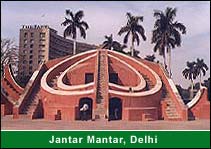 Company
representatives will receive you on arrival at the international airport in
Delhi late in the night or midnight. Transfer to your hotel. Relax.
Company
representatives will receive you on arrival at the international airport in
Delhi late in the night or midnight. Transfer to your hotel. Relax.
DELHI, the capital of kingdoms and empires is now a sprawling metropolis with a fascinating blend of the past and the present. It is a perfect introduction to the composite culture of an ancient land. A window to the kaleidoscope - that is India.
Overnight will be at Delhi.
Day 02 : Delhi - Jaipur
Breakfast will be at the hotel. Proceed to Jaipur.
Reach and check in at hotel.
JAIPUR - The origins of the beautiful city of Jaipur can be traced back to the eighteenth century, during the reign of Jai Singh II who ascended the Amber throne in 1699. Jaipur today, epitomizes the spirit of Rajputana. In-spite of growing into a bustling metropolis, it still retains its character and history - A beautiful fusion of the yesteryears and modernity. It is popularly known as the Pink City because of the extensive use of the locally abundant pink plastered stone, painted so in honor of the visit of the royal consort of Queen Victoria. Jaipur thrills the soul with its massive forts, magnificent palaces, exquisite temples and lush gardens.
Proceed for sightseeing of the city.
CITY PALACE - A delightful blend of Mughal and traditional Rajasthani architecture, the City Palace sprawls over one-seventh of the area in the walled city. It houses the Chandra Mahal, Shri Govind Dev Temple and the City Palace Museum.
JANTAR MANTAR - This is the largest and the best preserved of the five observatories built by Jai Singh II in different parts of the country. This observatory consisting of outsized astronomical instruments is still in use.
HAWA MAHAL - The ornamental facade of this "Palace of Winds" is a prominent landmark in Jaipur. Their five-storey structures of sandstone plastered pink encrusted with fine trelliswork and elaborate balconies. The palace has 953 niches and windows. Built in 1799 by Pratap Singh, the Mahal was a royal grandstand for the palace women.
Overnight will be at Jaipur.
Day 03 : Jaipur - Agra
By Road : 221 km in 6 hr
Breakfast will be served at the hotel.
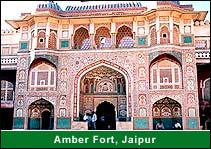
Proceed for excursion to Amber Fort in the outskirts of Jaipur. Elephant ride ascent to the fort.
AMBER FORT PALACE - Amber is the classic romantic Rajasthani fort palace. Its construction was started by Man Singh I in 1592, and completed by his descendent Jai Singh I. Its forbidding exterior belies an inner paradise where a beautiful fusion of Mughal and Hindu styles finds its ultimate expression.
Drive to Agra.
Reach Fatehpur Sikri after a light lunch break. The deserted, red Sandstone City, Emperor Akbar built that as his capital and palace in the late 16th century is an exhilarating experience. It a veritable fairytale city and its "ruins" are in pristine condition ... it's not hard to imagine what the court life must have been like in the days of its grandeur. Also visit the Bulund Darwaza, the largest gateway in the world.
Continue towards Agra and reach by evening. Check in at hotel.
AGRA: Two great Mughal monarchs, Akbar and Shah Jahan, transformed the little village of Agra into a befitting second capital of the Mughal Empire - giving it the name Dar-ul-Khilafat {seat of the Emperor}. Today a visitor to Agra is caught up in a world of contrasting edifices, of red sandstone and white marble, narrow galleys and quaint buggies, and that irresistible charm that this favorite city of the Mughals still retains. It is not surprising, that modern Agra still reflects its Mughal heritage most conspicuously. A walk down the narrow bustling streets of the city will introduce the visitor to the wafting aroma of Mughlai cuisine.
Overnight stay will be at Agra.
Day 04 : Agra - Umaria - Bandavgarh
By overnight train at 1515 hr
After breakfast proceed to visit Taj. Enjoy battery van ride to the Taj.
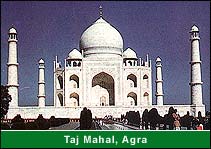 TAJ
MAHAL: Little needs to be said about this architectural wonder which is
always the soul raison-de-etre for every tourist's visit to Agra. Built by Shah
Jahan, the Taj is a white marble memorial to his beautiful wife Mumtaz Mahal.
This monument took 22 years to be completed and was designed, and planned by
Persian architect Ustad Isa. Apart from it's stunning design balance and perfect
symmetry, the Taj is also noted particularly for its elegant domes, intricately
carved screens and some of the best inlay work ever seen.
TAJ
MAHAL: Little needs to be said about this architectural wonder which is
always the soul raison-de-etre for every tourist's visit to Agra. Built by Shah
Jahan, the Taj is a white marble memorial to his beautiful wife Mumtaz Mahal.
This monument took 22 years to be completed and was designed, and planned by
Persian architect Ustad Isa. Apart from it's stunning design balance and perfect
symmetry, the Taj is also noted particularly for its elegant domes, intricately
carved screens and some of the best inlay work ever seen.
Proceed for sightseeing to the AGRA FORT - Built by the famed Mughal emperor Akbar in 1565 AD, the fort is predominantly of red sandstone. Ensconced within is the picture perfect Pearl Mosque, which is a major tourist attraction.
Visit Itmadullah's Tomb built by Empress NOOR JEHAN in memory of her father (The interiors of which are considered better than the Taj).
Take train to UMARIA. Overnight would be onboard the train.
Day 05 : Bandavgarh
Arrive early in the morning
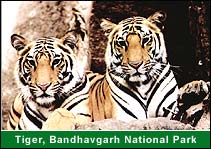 Reach
Bandavgarh and check in at hotel.
Reach
Bandavgarh and check in at hotel.
Bandavgarh is a new National Park with a very long history. Set among the Vindhya hills of Madhya Pradesh with an area of 168sq miles (437sq km) it contains a wide variety of habitats and a high density of game, including a large number of Tigers. This is also the White tiger country. These have been found in the old state of Rewa for Many years. Maharaja Martand Singh captured the last known in 1951. This white Tiger, Mohun is now stuffed and on display in the Palace of Maharaja of Rewa. Prior to becoming a National Park, the forests around Bandavgarh had long been maintained as a Shikargah, or game preserve of the Maharaja of Rewa. The Maharaja and his guests carried out hunting - otherwise the wildlife was well protected. It was considered a good omen for Maharaja of Rewa to shoot 109 tigers. His Highness Maharaja Venkat Raman Singh shot 111 Tigers by 1914.
There are 32 hills in this part of the park, which has a large natural fort at its center. The fort's cliffs are 2625 feet (800 meters) high, 1000 feet (300 meters) above the surrounding countryside. Winter temperatures (Nov-mid-February) vary from almost freezing at night to around 68 degree Fahrenheit in the daytime. Summer nights are also cooler than the daytime temperatures, which rise to 104 degree Fahrenheit. This park is closed during the breeding season, which coincides with the monsoon (July-October).
Bandavgarh has been a center of human activity and settlement for over 2000 years, and there are references to it in the ancient books, the Narad-Panch Ratra and the Shiva Purana. Legend has it that Lord Rama, hero of the Hindu epic, the Ramayana, stopped at Bandavgarh on his way back to his homeland after defeating the demon King Ravana of Lanka. Two monkey architects, who had engineered a bridge between the isle of Lanka and the mainland, are said to have built Bandavgarh's Fort. Later Rama handed it over to his brother Lakshmana who became known as Bandavdhish "The Lord of the Fort". Lakshmana is the particular God of the fort and is regularly worshipped in a temple there.
Bandavgarh is justifiably famous for its Tigers, but it has a wide range of other game. The undergrowth is not as dense as in some northern terai forests, but the best time to see the park inhabitants is still the summer months when water becomes more scarce and the undergrowth dies back.
Check in at the resort and overnight will be at Bandavgarh.
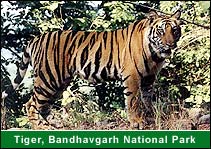 Day
06 : Bandavgarh
Day
06 : Bandavgarh
A full day game viewing inside the jungle. (Two safaris)
Overnight at the resort.
Day 07 : Bandavgarh
A full day game viewing inside the jungle. (Two safaris)
Overnight at the resort.
Day 08 : Bandavgarh - Khajuraho
By Road : 250km in 8 hr
After breakfast proceed to Khajuraho.
Reach and transfer to hotel.
Situated in the heart of India, in the state of Madhya Pradesh, Khajuraho is a fascinating village with a quaint, rural ambience and a rich cultural heritage, honored by the world as India's unique contribution to human civilization. The Chandela dynasty built eighty-five temples here. Only twenty remain as embodiments of Indian architectural and sculptural art at its most evolved state. Even ten centuries after they were constructed, the temples of Khajuraho reflect an eternal philosophy relevant to mankind. The temple of Khajuraho is a world heritage site and belongs not just to India but to the world. The nearby Panna national park is a project tiger park making the area a unique combination of outstanding cultural and natural heritage - one of the few millennium destinations of the world.
Explore the village in the evening. Visit SHILPAGRAM. Overnight will be at Khajuraho.
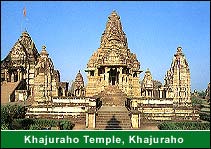 Day
09 : Khajuraho - Varanasi
Day
09 : Khajuraho - Varanasi
By Air
Proceed for a guided tour of the famous temples of Khajuraho after breakfast.
Transfer in time to airport for flight to Varanasi. Upon arrival at Varanasi, you will be met and transferred to hotel.
Varanasi is the World's most ancient living city. Sunrise on the riveRfront, as seen from a boat, can be spiritually uplifting sight. Crowded with temples, and its labyrinth of streets, the city attracts the maximum number of tourists. The religious capital of Hinduism, Varanasi is the carpet-manufacturing place of India. It was previously known as Kashi - the city that illuminates. The present name is derived from the fact that the city is at the confluence of the rivers Varuna and Asi.
Spend night at Varanasi.
Day 10 : Varanasi
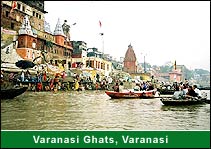 Drive
early morning to Daswamedh Ghat and take a boat ride on the sacred river Ganges
to see the cremation Ghats and witness the living traditions of one of the world's
oldest and most important religions. (To start at 0500 hrs. for the best lifetime
experience) For you to appreciate this remarkable city, we'll transfer you to
the banks of the River Ganges before the sun rises. Board a boat with your guide
and proceed to the middle of the river, where at sunrise the sight unfolds before
you. Thousands of faithful come daily to the banks to bathe and pray while in
the background, temples and palaces rise in tiers from the water's edge. Then
return for a walk through the cobblestone streets along the banks of "Ganga".
As shops are opening, the place now becomes a beehive of activity as the faithful
are coming and going. Also visit the Kashi Vishwanath Temple while returning
to the hotel.
Drive
early morning to Daswamedh Ghat and take a boat ride on the sacred river Ganges
to see the cremation Ghats and witness the living traditions of one of the world's
oldest and most important religions. (To start at 0500 hrs. for the best lifetime
experience) For you to appreciate this remarkable city, we'll transfer you to
the banks of the River Ganges before the sun rises. Board a boat with your guide
and proceed to the middle of the river, where at sunrise the sight unfolds before
you. Thousands of faithful come daily to the banks to bathe and pray while in
the background, temples and palaces rise in tiers from the water's edge. Then
return for a walk through the cobblestone streets along the banks of "Ganga".
As shops are opening, the place now becomes a beehive of activity as the faithful
are coming and going. Also visit the Kashi Vishwanath Temple while returning
to the hotel.
Return for breakfast to the hotel. Proceed for day guided tour of Varanasi including the Gyanvapi Mosque and Benaras Hindu University. Overnight will be at Varanasi.
Day 11 : Varanasi - Delhi
By Air
Breakfast will be at the hotel at hotel. Proceed for sightseeing of SARNATH.
Sarnath - 5 miles out of Varanasi for a day excursion: One of the holiest Buddhist sites in the world, where Buddha preached his first Sermon in 590 BC. Witness the ruins of a once flourishing Buddhist monastery and then visit a fine Museum which houses an excellent collection of Buddhist art and sculptures found at the site.
Transfer to airport for flight to Delhi. Reach Delhi and you will be transferred to hotel.
Overnight will be at Delhi.
 Day
12 : Delhi: Departure
Day
12 : Delhi: Departure
Proceed for a full-day tour of Old & New Delhi after breakfast.
OLD DELHI - A sightseeing tour of Old Delhi would entail visiting the Raj Ghat - the memorial site where Mahatma Gandhi was cremated; Jama Masjid - the largest mosque in India and the Red Fort - once the most opulent fort and palace of the Moghul Empire.
Enjoy a cycle rickshaw ride from Jama Masjid to Chandni Chowk.
NEW DELHI - An extensive sightseeing tour of New Delhi would include a visit to the Humayun's Tomb, the Qutub Minar, a drive along the ceremonial avenue - Rajpath, past the imposing India Gate, Parliament House, the President's Residence and would end with a drive through the Diplomatic Enclave.
Transfer to airport for flight home.
TOUR ENDS
Classical India Tour with Wildlife
Duration : 11 Nights & 12 Days
Destination Covered : Delhi - Jaipur - Agra - Umaria - Bandavgarh - Khajuraho - Varanasi - Delhi
Day 01 : Delhi
 Company
representatives will receive you on arrival at the international airport in
Delhi late in the night or midnight. Transfer to your hotel. Relax.
Company
representatives will receive you on arrival at the international airport in
Delhi late in the night or midnight. Transfer to your hotel. Relax. DELHI, the capital of kingdoms and empires is now a sprawling metropolis with a fascinating blend of the past and the present. It is a perfect introduction to the composite culture of an ancient land. A window to the kaleidoscope - that is India.
Overnight will be at Delhi.
Day 02 : Delhi - Jaipur
Breakfast will be at the hotel. Proceed to Jaipur.
Reach and check in at hotel.
JAIPUR - The origins of the beautiful city of Jaipur can be traced back to the eighteenth century, during the reign of Jai Singh II who ascended the Amber throne in 1699. Jaipur today, epitomizes the spirit of Rajputana. In-spite of growing into a bustling metropolis, it still retains its character and history - A beautiful fusion of the yesteryears and modernity. It is popularly known as the Pink City because of the extensive use of the locally abundant pink plastered stone, painted so in honor of the visit of the royal consort of Queen Victoria. Jaipur thrills the soul with its massive forts, magnificent palaces, exquisite temples and lush gardens.
Proceed for sightseeing of the city.
CITY PALACE - A delightful blend of Mughal and traditional Rajasthani architecture, the City Palace sprawls over one-seventh of the area in the walled city. It houses the Chandra Mahal, Shri Govind Dev Temple and the City Palace Museum.
JANTAR MANTAR - This is the largest and the best preserved of the five observatories built by Jai Singh II in different parts of the country. This observatory consisting of outsized astronomical instruments is still in use.
HAWA MAHAL - The ornamental facade of this "Palace of Winds" is a prominent landmark in Jaipur. Their five-storey structures of sandstone plastered pink encrusted with fine trelliswork and elaborate balconies. The palace has 953 niches and windows. Built in 1799 by Pratap Singh, the Mahal was a royal grandstand for the palace women.
Overnight will be at Jaipur.
Day 03 : Jaipur - Agra
By Road : 221 km in 6 hr
Breakfast will be served at the hotel.

Proceed for excursion to Amber Fort in the outskirts of Jaipur. Elephant ride ascent to the fort.
AMBER FORT PALACE - Amber is the classic romantic Rajasthani fort palace. Its construction was started by Man Singh I in 1592, and completed by his descendent Jai Singh I. Its forbidding exterior belies an inner paradise where a beautiful fusion of Mughal and Hindu styles finds its ultimate expression.
Drive to Agra.
Reach Fatehpur Sikri after a light lunch break. The deserted, red Sandstone City, Emperor Akbar built that as his capital and palace in the late 16th century is an exhilarating experience. It a veritable fairytale city and its "ruins" are in pristine condition ... it's not hard to imagine what the court life must have been like in the days of its grandeur. Also visit the Bulund Darwaza, the largest gateway in the world.
Continue towards Agra and reach by evening. Check in at hotel.
AGRA: Two great Mughal monarchs, Akbar and Shah Jahan, transformed the little village of Agra into a befitting second capital of the Mughal Empire - giving it the name Dar-ul-Khilafat {seat of the Emperor}. Today a visitor to Agra is caught up in a world of contrasting edifices, of red sandstone and white marble, narrow galleys and quaint buggies, and that irresistible charm that this favorite city of the Mughals still retains. It is not surprising, that modern Agra still reflects its Mughal heritage most conspicuously. A walk down the narrow bustling streets of the city will introduce the visitor to the wafting aroma of Mughlai cuisine.
Overnight stay will be at Agra.
Day 04 : Agra - Umaria - Bandavgarh
By overnight train at 1515 hr
After breakfast proceed to visit Taj. Enjoy battery van ride to the Taj.
 TAJ
MAHAL: Little needs to be said about this architectural wonder which is
always the soul raison-de-etre for every tourist's visit to Agra. Built by Shah
Jahan, the Taj is a white marble memorial to his beautiful wife Mumtaz Mahal.
This monument took 22 years to be completed and was designed, and planned by
Persian architect Ustad Isa. Apart from it's stunning design balance and perfect
symmetry, the Taj is also noted particularly for its elegant domes, intricately
carved screens and some of the best inlay work ever seen.
TAJ
MAHAL: Little needs to be said about this architectural wonder which is
always the soul raison-de-etre for every tourist's visit to Agra. Built by Shah
Jahan, the Taj is a white marble memorial to his beautiful wife Mumtaz Mahal.
This monument took 22 years to be completed and was designed, and planned by
Persian architect Ustad Isa. Apart from it's stunning design balance and perfect
symmetry, the Taj is also noted particularly for its elegant domes, intricately
carved screens and some of the best inlay work ever seen. Proceed for sightseeing to the AGRA FORT - Built by the famed Mughal emperor Akbar in 1565 AD, the fort is predominantly of red sandstone. Ensconced within is the picture perfect Pearl Mosque, which is a major tourist attraction.
Visit Itmadullah's Tomb built by Empress NOOR JEHAN in memory of her father (The interiors of which are considered better than the Taj).
Take train to UMARIA. Overnight would be onboard the train.
Day 05 : Bandavgarh
Arrive early in the morning
 Reach
Bandavgarh and check in at hotel.
Reach
Bandavgarh and check in at hotel. Bandavgarh is a new National Park with a very long history. Set among the Vindhya hills of Madhya Pradesh with an area of 168sq miles (437sq km) it contains a wide variety of habitats and a high density of game, including a large number of Tigers. This is also the White tiger country. These have been found in the old state of Rewa for Many years. Maharaja Martand Singh captured the last known in 1951. This white Tiger, Mohun is now stuffed and on display in the Palace of Maharaja of Rewa. Prior to becoming a National Park, the forests around Bandavgarh had long been maintained as a Shikargah, or game preserve of the Maharaja of Rewa. The Maharaja and his guests carried out hunting - otherwise the wildlife was well protected. It was considered a good omen for Maharaja of Rewa to shoot 109 tigers. His Highness Maharaja Venkat Raman Singh shot 111 Tigers by 1914.
There are 32 hills in this part of the park, which has a large natural fort at its center. The fort's cliffs are 2625 feet (800 meters) high, 1000 feet (300 meters) above the surrounding countryside. Winter temperatures (Nov-mid-February) vary from almost freezing at night to around 68 degree Fahrenheit in the daytime. Summer nights are also cooler than the daytime temperatures, which rise to 104 degree Fahrenheit. This park is closed during the breeding season, which coincides with the monsoon (July-October).
Bandavgarh has been a center of human activity and settlement for over 2000 years, and there are references to it in the ancient books, the Narad-Panch Ratra and the Shiva Purana. Legend has it that Lord Rama, hero of the Hindu epic, the Ramayana, stopped at Bandavgarh on his way back to his homeland after defeating the demon King Ravana of Lanka. Two monkey architects, who had engineered a bridge between the isle of Lanka and the mainland, are said to have built Bandavgarh's Fort. Later Rama handed it over to his brother Lakshmana who became known as Bandavdhish "The Lord of the Fort". Lakshmana is the particular God of the fort and is regularly worshipped in a temple there.
Bandavgarh is justifiably famous for its Tigers, but it has a wide range of other game. The undergrowth is not as dense as in some northern terai forests, but the best time to see the park inhabitants is still the summer months when water becomes more scarce and the undergrowth dies back.
Check in at the resort and overnight will be at Bandavgarh.
 Day
06 : Bandavgarh
Day
06 : BandavgarhA full day game viewing inside the jungle. (Two safaris)
Overnight at the resort.
Day 07 : Bandavgarh
A full day game viewing inside the jungle. (Two safaris)
Overnight at the resort.
Day 08 : Bandavgarh - Khajuraho
By Road : 250km in 8 hr
After breakfast proceed to Khajuraho.
Reach and transfer to hotel.
Situated in the heart of India, in the state of Madhya Pradesh, Khajuraho is a fascinating village with a quaint, rural ambience and a rich cultural heritage, honored by the world as India's unique contribution to human civilization. The Chandela dynasty built eighty-five temples here. Only twenty remain as embodiments of Indian architectural and sculptural art at its most evolved state. Even ten centuries after they were constructed, the temples of Khajuraho reflect an eternal philosophy relevant to mankind. The temple of Khajuraho is a world heritage site and belongs not just to India but to the world. The nearby Panna national park is a project tiger park making the area a unique combination of outstanding cultural and natural heritage - one of the few millennium destinations of the world.
Explore the village in the evening. Visit SHILPAGRAM. Overnight will be at Khajuraho.
 Day
09 : Khajuraho - Varanasi
Day
09 : Khajuraho - VaranasiBy Air
Proceed for a guided tour of the famous temples of Khajuraho after breakfast.
Transfer in time to airport for flight to Varanasi. Upon arrival at Varanasi, you will be met and transferred to hotel.
Varanasi is the World's most ancient living city. Sunrise on the riveRfront, as seen from a boat, can be spiritually uplifting sight. Crowded with temples, and its labyrinth of streets, the city attracts the maximum number of tourists. The religious capital of Hinduism, Varanasi is the carpet-manufacturing place of India. It was previously known as Kashi - the city that illuminates. The present name is derived from the fact that the city is at the confluence of the rivers Varuna and Asi.
Spend night at Varanasi.
Day 10 : Varanasi
 Drive
early morning to Daswamedh Ghat and take a boat ride on the sacred river Ganges
to see the cremation Ghats and witness the living traditions of one of the world's
oldest and most important religions. (To start at 0500 hrs. for the best lifetime
experience) For you to appreciate this remarkable city, we'll transfer you to
the banks of the River Ganges before the sun rises. Board a boat with your guide
and proceed to the middle of the river, where at sunrise the sight unfolds before
you. Thousands of faithful come daily to the banks to bathe and pray while in
the background, temples and palaces rise in tiers from the water's edge. Then
return for a walk through the cobblestone streets along the banks of "Ganga".
As shops are opening, the place now becomes a beehive of activity as the faithful
are coming and going. Also visit the Kashi Vishwanath Temple while returning
to the hotel.
Drive
early morning to Daswamedh Ghat and take a boat ride on the sacred river Ganges
to see the cremation Ghats and witness the living traditions of one of the world's
oldest and most important religions. (To start at 0500 hrs. for the best lifetime
experience) For you to appreciate this remarkable city, we'll transfer you to
the banks of the River Ganges before the sun rises. Board a boat with your guide
and proceed to the middle of the river, where at sunrise the sight unfolds before
you. Thousands of faithful come daily to the banks to bathe and pray while in
the background, temples and palaces rise in tiers from the water's edge. Then
return for a walk through the cobblestone streets along the banks of "Ganga".
As shops are opening, the place now becomes a beehive of activity as the faithful
are coming and going. Also visit the Kashi Vishwanath Temple while returning
to the hotel. Return for breakfast to the hotel. Proceed for day guided tour of Varanasi including the Gyanvapi Mosque and Benaras Hindu University. Overnight will be at Varanasi.
Day 11 : Varanasi - Delhi
By Air
Breakfast will be at the hotel at hotel. Proceed for sightseeing of SARNATH.
Sarnath - 5 miles out of Varanasi for a day excursion: One of the holiest Buddhist sites in the world, where Buddha preached his first Sermon in 590 BC. Witness the ruins of a once flourishing Buddhist monastery and then visit a fine Museum which houses an excellent collection of Buddhist art and sculptures found at the site.
Transfer to airport for flight to Delhi. Reach Delhi and you will be transferred to hotel.
Overnight will be at Delhi.
 Day
12 : Delhi: Departure
Day
12 : Delhi: Departure Proceed for a full-day tour of Old & New Delhi after breakfast.
OLD DELHI - A sightseeing tour of Old Delhi would entail visiting the Raj Ghat - the memorial site where Mahatma Gandhi was cremated; Jama Masjid - the largest mosque in India and the Red Fort - once the most opulent fort and palace of the Moghul Empire.
Enjoy a cycle rickshaw ride from Jama Masjid to Chandni Chowk.
NEW DELHI - An extensive sightseeing tour of New Delhi would include a visit to the Humayun's Tomb, the Qutub Minar, a drive along the ceremonial avenue - Rajpath, past the imposing India Gate, Parliament House, the President's Residence and would end with a drive through the Diplomatic Enclave.
Transfer to airport for flight home.
TOUR ENDS
Click here for Reservation / More Information
Wildlife Tours
India
Indian Wildlife Tour Wildlife
Tour of India and Nepal
Wildlife
Tour of India and Nepal  Tiger
Safari India
Tiger
Safari India  Extensive
Tiger Tour of North India
Extensive
Tiger Tour of North India
Tiger Safari with Taj Tiger and
Wild Dogs
Tiger and
Wild Dogs  Tiger and
Bird Tour
Tiger and
Bird Tour  Grand
Wildlife Tour of India and Nepal
Grand
Wildlife Tour of India and Nepal
Royal and Rustic Rajasthan with Wildlife Birding
Tour of North India
Birding
Tour of North India  Bamboo Rafting and
Elephant Bathing
Bamboo Rafting and
Elephant Bathing
Camel Safari in Rajasthan Wildlife Tour of Rajasthan
with Classical India
Wildlife Tour of Rajasthan
with Classical India  Wildlife
and Beaches of Kerala
Wildlife
and Beaches of Kerala
Classical India Tour with Wildlife Taj Tigers Tradition
Taj Tigers Tradition
 Tiger &
Birds Tours
Tiger &
Birds Tours  Birding
Tour India
Birding
Tour India
Wildlife & Adventure Wildlife
Tour Package
Wildlife
Tour Package  Elephant
Safari
Elephant
Safari  more...
more...
Indian Wildlife Tour
Tiger Safari with Taj
Royal and Rustic Rajasthan with Wildlife
Camel Safari in Rajasthan
Classical India Tour with Wildlife
Wildlife & Adventure
| Home | About Us | FAQ's | Contact Us | Commendations | Reservation |
| Copyright © Wildlife India Plus ( All Rights Reserved. ) | Web Development & SEO Services by |

